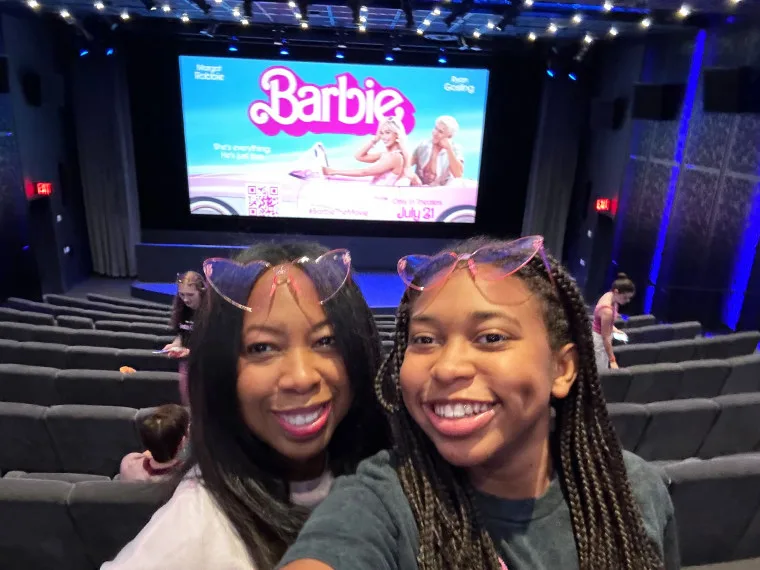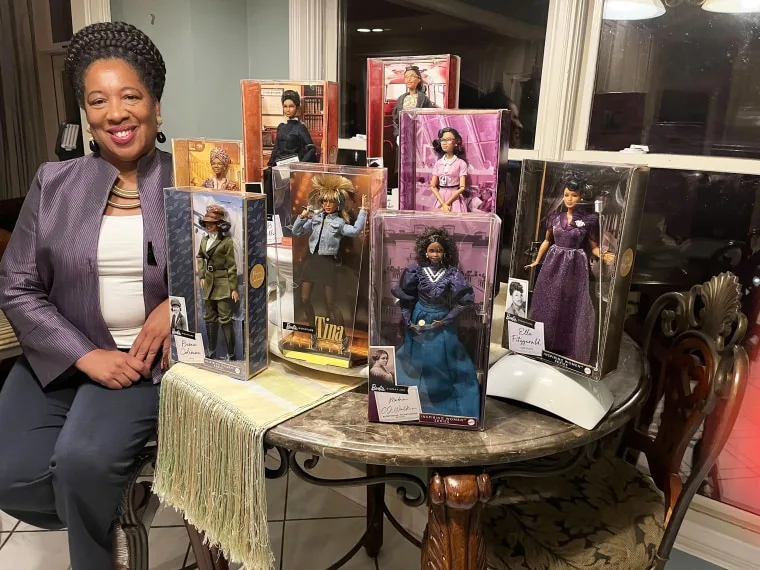Angela Williams, a Black writer in her 40s, remembers getting her first Black Barbie doll like it was yesterday.
“My first Black Barbie came as a hand me down from one of my sisters. I have three older sisters and I think I was probably six or seven years old when I got it,” she tells TODAY.com.
Although the doll was missing some accessories due to her sisters’ lack of consideration for the toy, Angela Williams said she still loved the doll like no other.
“I think by the time she was passed on to me, her shoes were gone. But I didn’t care that she didn’t have shoes or she didn’t have anything special. She was just special because of the way she looked.”
The doll mirrored some of Angela Williams’ features, sporting preppy dark hair, a “simple” blue dress and dark skin. But, the best part about the toy was how the doll could come to life by simply using your imagination.
“You know how there’s one person in the group of friends that always tends to lead the pack and they have the ideas and everybody wants to be with them because they’re so cool. That was my Barbie,” she said.
“She was almost like the queen of the core because she stood out and she was different,” the journalist adds.
Having only played with white dolls before, a young Angela Williams knew exactly what she wanted to do with her new friend.
First, she built a home for her Barbie using boxes that were found around the house, and when her doll would take a walk through her made-up town, she said, “Everybody would be happy to see her” because of the way she “strutted” her stuff.
“Everybody kind of looked up to her. So I guess for me, I made my Barbie like the very special person that I thought I should be,” she said.
‘She’s black! She’s beautiful! She’s dynamite!’
The type of inspiration that Angela Williams received from playing with her doll was unlikely unheard of for Black girls in 1959. That year, Barbie made her debut at toy stores and the fashionista came equipped with platinum blonde hair and piercing blue eyes. While it seemed little white girls could imagine their future with the “country’s first mass-marketed adult-looking doll for girls,” according to The New York Times, it was hard for children of color to do the same.
It wasn’t until 1967 that Mattel, the company that manufactures Barbie, made its first dark-skinned doll.
Her name was Francie and she came with a cool twist-and-turn feature in her waist that made her even more fun to play with. But while she seemed to promote inclusivity in the toy industry, along with Christie, a more popular Black doll that came out a year after her, none of them were actually seen as Black Barbie dolls.
According to the Independent, Francie and Christie were part of “several Black dolls” that Mattel released as Barbie’s friends. Though they lived in the icon’s plastic world, they were just a shadow of existence compared to Barbie.
Black girls would have to wait at least 10 more years before the first official Black Barbie doll would hit the market.
However, when she arrived, she didn’t disappoint. In 1980, the first Black doll named Barbie made her debut wearing a fabulous red jumpsuit with a wrap-and-snap disco skirt. Her striking attire was created by Kitty Black Perkins, a Black fashion designer who eventually became Mattel’s Chief Designer of Fashions and Coll Concepts and was credited for creating more than 100 designs.
According to the National Museum of Play, the Barbie was sold in a box that read, “She’s black! She’s beautiful! She’s dynamite!”
While her release appeared to be a moment of progress in the toy industry, professor Patricia A. Turner, who teaches African American studies at University of California, Los Angeles, said that people should not be so quick to think that the Black Barbie was solely created to address issues with representation.
Black Barbie emerged when Black Americans began to experience upward mobility
Turner, a senior dean at UCLA, said society was rapidly changing in the years leading up to Black Barbie’s release, which was in part due to the civil rights movement that happened in the ‘50s and ‘60s.
“It’s probably not a coincidence that the first Black Barbie emerged when she did,” she tells TODAY.com. “The 80s gets us out of the formal years of the civil rights movement.”
“During that time,” she continues, “there were justice boycotts and civil unrest from the African American community.”
Because of the movement, Turner said, Black people started to progress in society and made their way into the “middle class, upper middle class and more affluent ranks” that were available to them. As Black people started to experience upward mobility, she said it only made sense for companies to start marketing toward them.
“Companies that are interested in securing a profit understand that they need to market to that community,” she said.
“I know it was not uncommon in that era for African Americans to be invisible,” she adds. “One of the reasons that girls and their mothers wanted the Black Barbie was to correct that invisibility.”
As more and more Black Barbies were getting sold, Mattel decided to give the burgeoning dolls a little bit of a refurbish by selling them as career-driven women who kids could look up to.
In 1989, the company made a Black Barbie who was a pilot, and in 1993, there was another Black Barbie, who served as a medical sergeant. In the years following, Mattel released other Black Barbies including a medical sergeant, a firefighter and in 2004, a Black Barbie president.
Barbie becomes the ‘most diverse doll line on the market’
By the time 2015 came around, Mattel found more ways to be inclusive — this time introducing Barbies with different body types and characteristics to help people feel more seen in the toy industry. In 2019, the company came out with its first Barbie doll in a wheelchair and another that has a prosthetic leg, thus helping to solidify Barbie’s place as “the most diverse doll line on the market,” said Lisa McKnight, Executive Vice President and Global Head of Barbie & Dolls, Mattel, in a statement.
Some of this inclusivity can be seen in Greta Gerwig’s new “Barbie” movie, which has been hailed for its diverse cast.
“I thought it was really cool,” Angela Williams’ 14-year-old daughter, Nyla Smith, told TODAY.com of the film. “I liked the references they used to Barbie dolls and their style and I thought it was really cool how they made it more inclusive for everyone.”

In the film, Issa Rae, a Black actor who is known for her entrepreneurial endeavors, plays President Barbie, a role that has yet to be occupied by a woman in the real world.
When asked how she feels about a Black woman playing president, Angela Williams’ older sister Elizabeth, who is also an avid Black Barbie collector, told TODAY.com, “It’s about time!”
“I think it’s fabulous and I think Issa Rae is a fabulous person,” said Elizabeth Wilson, the executive director of Georgia Micro Enterprise Network.
“It just makes sense that Barbie should always be leading the way and showing us what’s next,” she adds.
Though the audience reviews of “Barbie” are still coming in, rivaling the release of another critically-acclaimed blockbuster, director Christopher Nolan’s film “Oppenheimer,” Elizabeth Wilson said she’s hopeful that little girls of color will leave with something positive after seeing the film.
“I’m hoping that they’ll see themselves as a future Barbie,” she said. “Maybe they’ll say to themselves, ‘Oh, I can do that too. I can be that.”
Like her sister Angela, Elizabeth Wilson found a lot of joy from playing with Black Barbies as a child. Currently, she has eight Black Barbie dolls in her possession, and she said she won’t be selling any of them anytime soon.
Aside from collecting, Elizabeth Wilson also buys her niece Nyla a Black Barbie every now and then. When she was younger, the teen used to have an impressive Barbie collection that included an airplane, jeep and cruise ship.




“I didn’t have a lot of that in my childhood. So I wanted to make certain that most of the dolls in our home reflected the world that she lives in and I wanted her to see that her dolls were just as beautiful as any white doll you can get,” Angela Williams said.
But once Nyla became a certain age, she donated most of her collection to a friend at her mom’s local church. Now, she just has a few dolls at home.
While thinking about the important role that her Black Barbies played in her life, Nyla said she was so “excited” to “have dolls that looked like me.” And if the toy came with straight hair, her mom would help her wash the doll’s locks so it would have the same “big fluffy curly hair” that Nyla donned herself.
Helping her kid feel more represented in society is just one way Angela Williams is teaching her daughter that Black is beautiful.
In an attempt to give her daughter a more robust childhood, Angela Williams is making sure Nyla doesn’t repeat the same mistakes she did.
“I honestly didn’t realize the value of having a doll that looked like me until I was older,” she said. “Until it was time for me to stop playing with them.”


